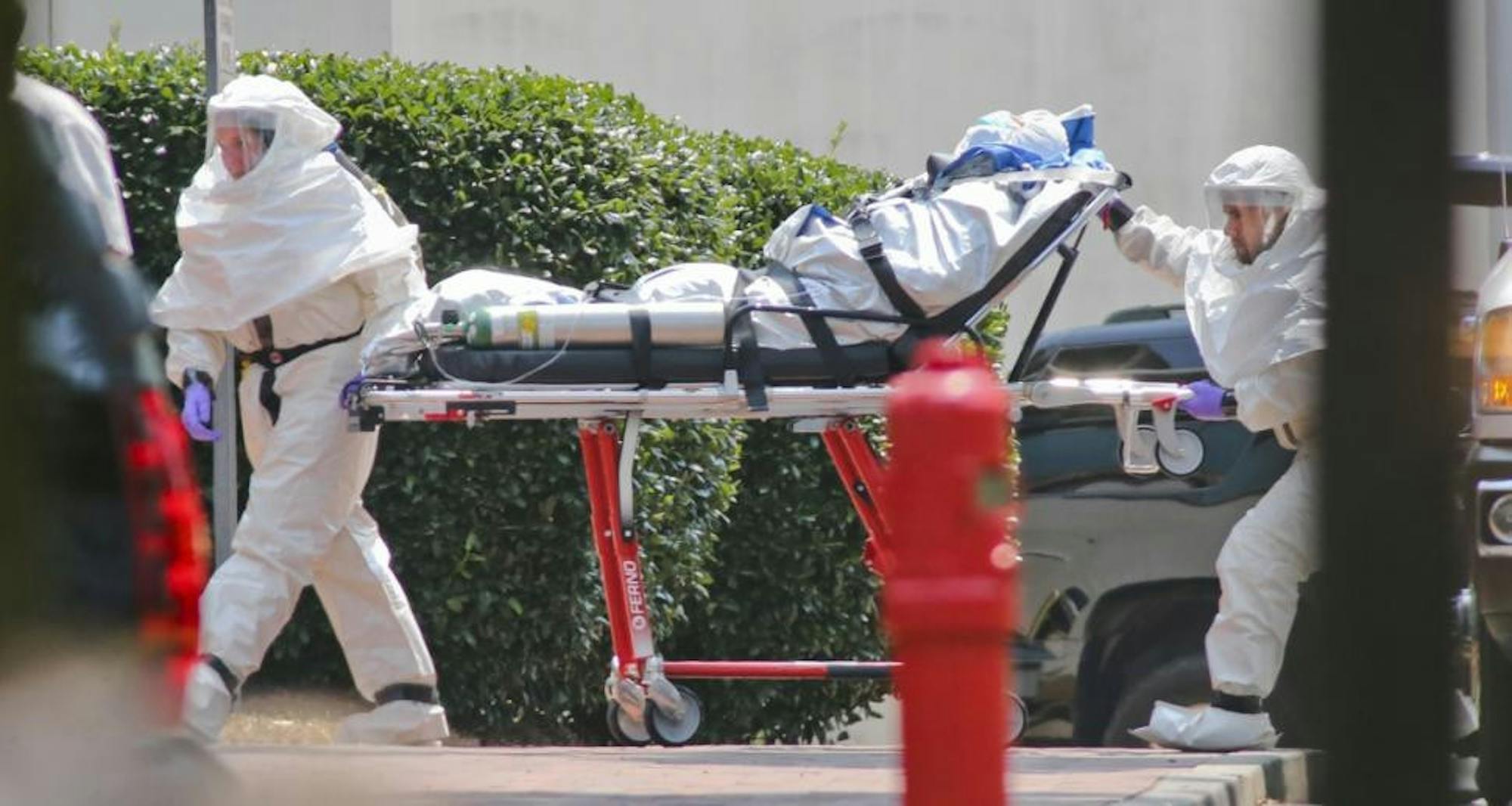
Faculty transport an Ebola patient into Emory University Hospital | Photo courtesy Flickr Creative Commons
A panel of Nell Hodgson Woodruff School of Nursing alumni who treated four Ebola virus patients at the Emory University Hospital discussed media attention during the epidemic, connecting with patients’ families and the lack of hierarchy at Emory Hospital’s Infectious Disease Unit at the Rollins School of Public Health Auditorium on Thursday night.
Laura Mitchell, who earned her Bachelors of Science in Nursing (BSN) from Emory’s Nursing School in 1997; Jason Slabach, who earned his BSN in 2013 and Crystal Johnson, who earned her BSN in 2000 chaired the panel, titled “Beyond the Headlines: How Emory Nurses Fought Ebola.” The three recounted their experiences while taking care of patients Dr. Kent Brantly, missionary Nancy Writebol, nurse Amber Vinson and Dr. Ian Crozier between August and November.
A major topic of the predominantly question-and-answer panel session, attended by around 100 students and faculty, was the ability of nurses, unlike many infectious disease doctors, specialists and lab workers, to form emotional connections with patients and families, even through their personal protective equipment (PPE).
“The PPE didn’t really interfere with caring for the patient,” Johnson said before adding, to laughs from the audience, “The main concern was going to the bathroom.”
“He called back, ‘Mom,’ and I thought, ‘I hope that is not the last thing he ever says.’” — Laura MitchellSlabach added that on one day during Writebol’s hospitalization, several nurses in PPE gave her a pedicure.
“She just really wanted to feel pretty again,” he said, adding that Writebol was “someone who always wore makeup.”
As for comforting patients’ family members, all three panelists recounted stories of times when the nurses bonded with their significant others, parents and relatives who couldn’t touch their quarantined loved ones.
“There’s no privacy in the [Infectious Disease] Unit — you can hear everything,” Johnson said. “To hear those conversations about ‘What are we going to do if he doesn’t make it?’ [Crozier’s mother’s] greatest fear was that he would die without her being able to touch him.”
Mitchell recalled a time when, as Crozier’s condition worsened, she quickly cracked the door to his quarantined room so that his mother could call out his name.
“He called back, ‘Mom,’ and I thought, ‘I hope that is not the last thing he ever says,’” Mitchell said.
While Slabach mentioned happier times about going out for drinks with Crozier’s brother and girlfriend, he also said Crozier’s mother often brought the team to tears with her daily poetry readings to her son through an intercom.
“It was a lot of symbolism about beating the disease, and it would just emotionally destroy you every day,” he said.
In addition to family and patient care, all three nurses described the collaborative environment within the hospital’s Infectious Disease Unit.
“Even Dr. [Bruce] Ribner, who was sort of the godfather of our unit, helped me clean up the biggest bowel movement I’ve ever seen,” Slabach said to resounding laughs from the audience. “It wasn’t even him helping me so much — he was like, ‘Jason, tell me what to do!’”
Johnson mentioned the fact that while many of the doctors treating the four patients had much more technical expertise at their disposal, they lacked in the area of critical care.
“The relationship between them and us was on one level,” Johnson said.
The team within the Infectious Disease Unit operated under five “family rules:” following standard operating procedures, making sure friends follow standard operating procedures, reporting all incidents, reporting new medical conditions and reporting signs and symptoms, according to Slabach.
“Creating that culture of safety from the very beginning is what made us so successful,” Slabach said.
The nurses also described how, outside of the Infectious Disease Unit, their relationships with their families changed in light of the media portrayal of the epidemic.
Though her mother always knew she was part of the unit, Johnson said, she worried about the health risks in place.
“My brother suggested I get my affairs in order,” Johnson said.
Slabach recalled watching CNN reports about Emory’s patients while standing in the room with them and overhearing people nearby exaggerating the epidemic’s threat to the U.S.
Throughout the discussion, the nurses emphasized the disparity between their resources and those of the health care workers in West Africa.
“The people in West Africa are the real heroes — our situation was completely different,” Slabach said, who recalled stories from colleagues in West Africa who dumped sweat from their boots after hours of tending to patients while wearing PPE in un-airconditioned rooms. “People always say, ‘we need more money,’ but we really do have unlimited resources.”
First-year nursing student Claudia Garcia, who attended the panel, said it was interesting to view the treatment of the patients through the perspectives of the nurses themselves.
“They showed just how important it is to pay attention to detail — to do everything very meticulously,” Garcia said.
Tanya Garcia, another first-year nursing student who is not related to Claudia, said that, after learning about PPEs, “it was great to see that Emory really put [the lessons] into practice.”
College senior Ruku Machiwalla, who also attended, called the panel discussion “amazing.”
“I respect these nurses so much,” Machiwalla said. “It was incredibly brave of them to put so much at risk for the lives of others.”
— By Lydia O’Neal, Asst. News Editor





